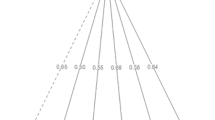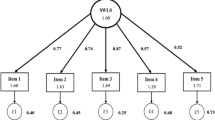Abstract
The purpose of this study is to develop an instrument for measuring the cognitive domain of the quality of life of university students, and to report the validity and reliability of the scales that are created. The study uses a representative sample of undergraduate students from the faculty of education at a major Canadian university. The construct validity of the scales is assessed by Thomas Piazza's procedures for analyzing attitudinal items. The findings support conceptualizing the cognitive domain in terms of Structural and Functional dimensions. The Structural Dimension includes the Knowledge and Comprehension dimensions from Bloom's taxonomy and the Functional Dimension includes the Application, Analysis, Synthesis, and Evaluation dimensions. The alpha reliability coefficients of the two scales are 0.88 and 0.85, respectively. Some potential applications of these scales for understanding educational attainments, as well as for the evaluation of university departments and faculties, are suggested.
Similar content being viewed by others
References
Astin, A. W.: 1993, What Matters in College? Four Critical Years Revisited (Jossey-Bass, San Francisco, CA).
Austin, G. R. and H. Garber: 1985, Research on Exemplary Schools (Academic Press, Orlando, FL).
Bloom, B. S., M. D. Engelhart, E. J. Furst, W. H. Hill and D. R. Krathwohl: 1956, Taxonomy of Educational Objectives, Handbook I: Cognitive Domain (David Mackay, New York).
Bohrnstedt, G. and D. A. Knoke: 1982, Statistics for Social Data Analysis (F.E. Peacock, Ithaca, IL).
Burt, R. S., J. A. Wiley, M. J. Minor and J. R. Murray: 1978, ‘Structure of well being’, Sociological Methods and Research 6, pp. 365–407.
Carmines, E. G. and R. A. Zeller: 1979, Reliability and Validity Assessment (Sage Publications, Beverly Hills, CA).
Clifton, R. A., D. Mandzuk and L. W. Roberts: 1994, ‘The alienation of undergraduate education students: a case study of a Canadian university’, Journal of Education for Teaching 20, pp. 179–192.
Clifton, R. A. and L. W. Roberts: 1993, Authority in Classrooms (Prentice-Hall, Toronto, ON).
Coser, R. L.: 1979, Training in Ambiguity (The Free Press, New York).
Fraser, B. J.: 1986, Classroom Environment (Croom Helm, London).
Gibson, S. and M. H. Dembo: 1984, ‘Teacher efficacy: a construct validation’, Journal of Educational Research 76, pp. 569–582.
Harman, H. H. 1967, Modern Factor Analysis (University of Chicago Press, Chicago, IL).
Jackson, S. E.: 1981, ‘Measurement of commitment to role identities’, Journal of Personality and Social Psychology 40, pp. 138–146.
Kim, J. O. and C. W. Mueller: 1978a, Introduction to Factor Analysis: What it is and how to do it (Sage Publications, Beverly Hills, CA).
Kim, J. O. and C. W. Mueller: 1978b, Factor Analysis: Statistical Methods and Practical Issues (Sage Publications, Beverly Hills, CA).
Kleinfeld, J. S.: 1975, ‘Effective teachers of Eskimo and Indian students’, School Review 83, pp. 301–344.
Larson, J. S.: 1993, ‘The measurement of social well-being’, Social Indicators Research 28, pp. 285–296.
Michaelos, A. C.: 1986. ‘Job satisfaction, marital satisfaction, and the quality of life: a review and a preview’ in F. M. Andrews (ed.), Research on the Quality of Life (University of Michigan, Ann Arbor, MI), pp. 57–83.
Nachmias, D. and C. Nachmias: 1987, Research Methods in the Social Sciences (St. Martin's Press, NY).
Nunnally, J. C.: 1967, Psychometric Theory (McGraw-Hill, NY).
Palys, T. S. and B. R. Little: 1980, ‘Social indicators and the quality of life’, Canadian Psychologist 21, pp. 67–74.
Pascarella, E. T.: 1985, ‘College environmental influences on learning and cognitive development: a critical review and synthesis’ in J. Smart (ed.), Higher Education: Handbook of Theory and Research, Vol. 1 (Agathon Press, NY), pp. 1–61.
Pascarella, E. T. and Terenzini, P. T.: 1991, How College Affects Students: Findings and Insights from Twenty Years of Research (Jossey-Bass, San Francisco, CA).
Piazza, T.: 1980, ‘The analysis of attitude items’, American Journal of Sociology 86: pp. 584–603.
Raths, L. E., S. Wasserman, A. Jonas and A. Rothstein: 1986: Teaching for Thinking: Theory, Strategies, and Activities for the Classroom (Teachers College, Columbia University, NY).
Roberts, L. W. and R. A. Clifton: 1992, ‘Measuring the affective quality of life of university students: the validation of an instrument’, Social Indicators Research 28, pp. 113–137.
Schuessler, K. F. and G. A. Fisher: 1985, ‘Quality of life research and sociology’, Review of Sociology 11, pp. 129–149.
Seddon, G. M.: 1978, ‘The properties of Bloom's taxonomy of educational objectives for the cognitive domain’, Review of Educational Research 48, pp. 303–323.
Singleton, R., B. C. Straits, M. M. Straits and R. J. McAllister: 1988, Approaches to Social Research (Oxford University Press, NY).
Smith, M. L. and G. V. Glass: 1987, Research and Evaluation in Educational and the Social Sciences (Prentice-Hall, Englewood Cliffs, NJ).
Stinchcombe, A. L. and J. C. Wendt: 1975, ‘Theoretical domains and measurement in social indicator analysis’, in K. C. Land and S. Spilerman (eds.) Social Indicator Models (Russell Sage Foundation, NY), pp. 37–73.
Tabachnick, B. G. and L. S. Fidell: 1989, Using Multivariate Statistics (Harper and Row, NY).
Williams, T. and M. Batten: 1981, The Quality of School Life (The Australian Council for Educational Research, Hawthorn, Victoria).
Author information
Authors and Affiliations
Additional information
The names are alphabetical and the authors contributed equally in writing this paper.
Rights and permissions
About this article
Cite this article
Clifton, R.A., Etcheverry, E., Hasinoff, S. et al. Measuring the cognitive domain of the quality of life of university students. Soc Indic Res 38, 29–52 (1996). https://doi.org/10.1007/BF00293785
Accepted:
Issue Date:
DOI: https://doi.org/10.1007/BF00293785




